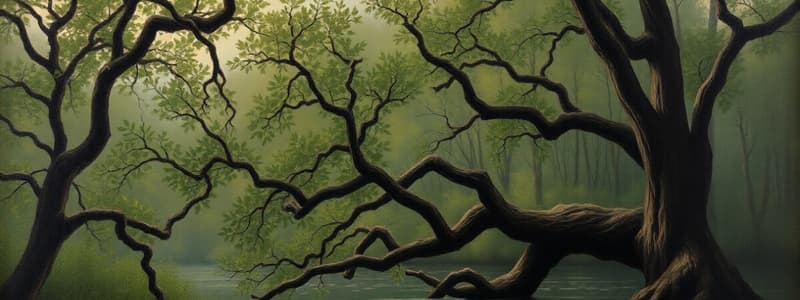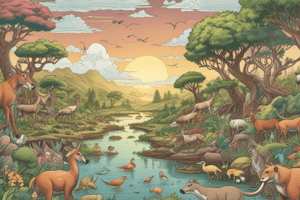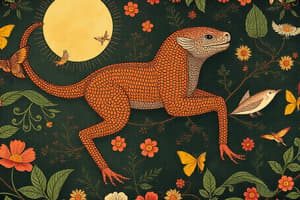Podcast
Questions and Answers
What term describes the organisms at the beginning of a food chain that produce energy through photosynthesis?
What term describes the organisms at the beginning of a food chain that produce energy through photosynthesis?
Producers
In a food chain, what is the role of primary consumers?
In a food chain, what is the role of primary consumers?
Primary consumers eat producers and are usually herbivores.
What happens to the energy in a top carnivore when it dies?
What happens to the energy in a top carnivore when it dies?
Detritivores and decomposers feed on the dead organism.
What is the significance of arrows in a food chain diagram?
What is the significance of arrows in a food chain diagram?
Define the term 'trophic level' in the context of a food chain.
Define the term 'trophic level' in the context of a food chain.
What type of organisms start a food chain and what process do they use to create energy?
What type of organisms start a food chain and what process do they use to create energy?
Identify and define the roles of different trophic levels in a food chain.
Identify and define the roles of different trophic levels in a food chain.
Describe the feeding behavior that allows animals like the blenny to occupy multiple trophic levels.
Describe the feeding behavior that allows animals like the blenny to occupy multiple trophic levels.
Why are food webs preferred over food chains for representing ecosystems?
Why are food webs preferred over food chains for representing ecosystems?
Explain the significance of having alternative food sources for animals in an ecosystem.
Explain the significance of having alternative food sources for animals in an ecosystem.
What organisms are primary consumers in a food web that includes waterweed and kingfishers?
What organisms are primary consumers in a food web that includes waterweed and kingfishers?
In the desert food web, what role do bats play regarding mice and crickets?
In the desert food web, what role do bats play regarding mice and crickets?
Identify the apex predator in the pond food web that includes herons, spikefish, and bluefish.
Identify the apex predator in the pond food web that includes herons, spikefish, and bluefish.
What is one key difference between a food chain and a food web?
What is one key difference between a food chain and a food web?
Name a mutualistic or competitive interaction that might occur in the forest ecosystem with eucalyptus trees.
Name a mutualistic or competitive interaction that might occur in the forest ecosystem with eucalyptus trees.
Flashcards
Food Chain
Food Chain
A sequence of organisms showing who eats whom in an ecosystem, illustrating the transfer of energy.
Producer
Producer
An organism, like a plant, that makes its own food (energy) using sunlight through photosynthesis.
Consumer
Consumer
An organism that eats other organisms for energy.
Primary Consumer
Primary Consumer
Signup and view all the flashcards
Secondary Consumer
Secondary Consumer
Signup and view all the flashcards
Tertiary Consumer
Tertiary Consumer
Signup and view all the flashcards
Trophic Level
Trophic Level
Signup and view all the flashcards
Herbivore
Herbivore
Signup and view all the flashcards
Carnivore
Carnivore
Signup and view all the flashcards
Omnivore
Omnivore
Signup and view all the flashcards
Food Chain
Food Chain
Signup and view all the flashcards
Trophic Levels
Trophic Levels
Signup and view all the flashcards
Producer
Producer
Signup and view all the flashcards
Autotroph
Autotroph
Signup and view all the flashcards
Heterotroph
Heterotroph
Signup and view all the flashcards
Consumer
Consumer
Signup and view all the flashcards
Primary Consumer
Primary Consumer
Signup and view all the flashcards
Secondary Consumer
Secondary Consumer
Signup and view all the flashcards
Tertiary Consumer
Tertiary Consumer
Signup and view all the flashcards
Quaternary Consumer
Quaternary Consumer
Signup and view all the flashcards
Food Web
Food Web
Signup and view all the flashcards
Producer (trophic level 1)
Producer (trophic level 1)
Signup and view all the flashcards
Primary Consumer (trophic level 2)
Primary Consumer (trophic level 2)
Signup and view all the flashcards
Secondary Consumer (trophic level 3)
Secondary Consumer (trophic level 3)
Signup and view all the flashcards
Tertiary Consumer (trophic level 4)
Tertiary Consumer (trophic level 4)
Signup and view all the flashcards
Food Chain
Food Chain
Signup and view all the flashcards
Food Web
Food Web
Signup and view all the flashcards
Cricket
Cricket
Signup and view all the flashcards
Kingfisher
Kingfisher
Signup and view all the flashcards
Redfin
Redfin
Signup and view all the flashcards
Duckweed
Duckweed
Signup and view all the flashcards
Lizard
Lizard
Signup and view all the flashcards
Carp
Carp
Signup and view all the flashcards
Trout
Trout
Signup and view all the flashcards
Algae
Algae
Signup and view all the flashcards
Heron
Heron
Signup and view all the flashcards
Spikefish
Spikefish
Signup and view all the flashcards
Crowfish
Crowfish
Signup and view all the flashcards
Tadpole
Tadpole
Signup and view all the flashcards
Dragonfly Larva
Dragonfly Larva
Signup and view all the flashcards
Bluefish
Bluefish
Signup and view all the flashcards
Bat
Bat
Signup and view all the flashcards
Hawk
Hawk
Signup and view all the flashcards
Mouse
Mouse
Signup and view all the flashcards
Starling
Starling
Signup and view all the flashcards
Wasp
Wasp
Signup and view all the flashcards
Goshawk
Goshawk
Signup and view all the flashcards
Sap-sucking insects
Sap-sucking insects
Signup and view all the flashcards
Leaf-eating insects
Leaf-eating insects
Signup and view all the flashcards
Cactus
Cactus
Signup and view all the flashcards
Grass
Grass
Signup and view all the flashcards
Study Notes
Food Chains
- Food chains illustrate feeding relationships and energy flow within an ecosystem.
- Arrows show the direction of energy transfer.
- Each organism in a food chain represents a trophic level.
- Producers (autotrophs) are at the base, making their own food via photosynthesis. Plants, algae, and seaweed are examples.
- Consumers are organisms that eat other organisms for food.
- Primary consumers eat producers.
- Secondary, tertiary, and sometimes quaternary consumers feed on organisms a level below them in the food chain.
- Carnivores consume other animals, herbivores only consume plants. Omnivores eat both animals and plants.
- The top carnivore is at the end of the food chain.
- Detritivores and decomposers break down dead organisms.
Food Webs
- Food webs show interconnected feeding relationships within an ecosystem.
- Food chains are simpler; food webs are more complex and realistic because animals often consume various types of food.
- Availability of food may vary according to seasons and certain environmental conditions.
- A food web is easier to use because of this more complex description.
- Food webs depict feeding relationships more realistically because of the variety of organisms in an ecosystem.
Energy Flow
- Energy is lost at each trophic level (about 90%).
- This is because energy is used for an organism's life processes and not all the organism can be consumed and digested. For example, the bones, feathers and hair cannot be digested.
- There are usually four or five trophic levels in a food chain.
- Detritivores and decomposers convert dead remains into nutrients usable by producers, and thus energy is returned to the start of the food chain.
Studying That Suits You
Use AI to generate personalized quizzes and flashcards to suit your learning preferences.




